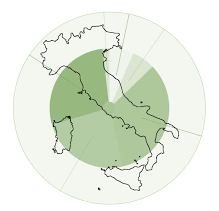Over the past two decades, differences in health and life expectancy in the United States have become increasingly pronounced. These inequalities, often related to place of residence, economic conditions, and racial and ethnic identity, have reached alarming levels. A study published in the prestigious journal The Lancet found that these differences have divided the country into ten mutually exclusive populations, referred to by the authors as “The Ten Americas.”
This classification is an attempt to map health inequalities based on a combination of geographic, socioeconomic and demographic factors. Each group represents a microcosm of American society, showing how health can vary dramatically based on where you live, how much you earn, and what your cultural and racial background is.
Life expectancy: a key indicator
Life expectancy is one of the most reliable indicators of a population’s health status. In 2000, the gap in life expectancy among the “Ten Americas” was already significant at 12.6 years. However, by 2021, this gap has grown to 20.4 years, a figure that reflects worsening inequalities, further accentuated by the COVID-19 pandemic.
In 2021, Americans of Asian descent had the highest life expectancy of 84 years. At the opposite end of the spectrum, Native Americans and Alaskans (AIAN) residing in the West had a life expectancy of only 63.6 years. This difference of more than two decades represents one of the largest health disparities recorded in the developed world.
Major trends and the most affected groups
Between 2000 and 2010, life expectancy increased in nine of the ten Americas, reflecting advances in medicine, technology and health policies. However, from 2010 to 2019, this trend slowed considerably, with improvements observed in only six groups. In 2020, the first year of the pandemic, life expectancy declined in all Americas, with AIAN communities in the West experiencing the most dramatic decline-a loss of 6.6 years in just two years.
AIAN communities have been disproportionately affected by the pandemic, but COVID-19 has only exacerbated existing problems. These populations have faced a range of systemic challenges for decades that perpetuate socioeconomic and health inequalities. Lack of access to quality health care, chronic underfunding of dedicated health services, high rates of unemployment, and low levels of education contribute to a higher risk of mortality from preventable diseases, overdoses, and COVID-19.
Racial and geographical inequalities
The study identified profound disparities in life expectancy across racial and ethnic groups, also influenced by geographic location and income. For example, African Americans living in rural and low-income areas in the South (America 9) and in highly segregated cities (America 7) saw slight increases in life expectancy through 2010, but followed by a halt in progress in subsequent years. This stagnation reflects a combination of factors, including limited access to medical care, high rates of chronic disease, and increased exposure to environmental hazards.
Another significant example involves Asian Americans, who, despite having the highest life expectancy among all groups, are not immune to inequality. Asians living in low-income or highly segregated communities may experience significantly worse health outcomes than those living in more affluent areas.
What drives these inequalities?
Differences in education and income levels only partially explain inequalities in life expectancy. For example, whites, Asians and AIANs residing in counties with higher incomes (America 3) did not always show a correspondingly high life expectancy. This suggests that other factors, such as disparities in access to health care or public policies, play a crucial role.
Another important element is the environmental context. Many disadvantaged communities live in areas with high levels of pollution, exposure to toxic substances, and poor availability of green space. These environmental factors can contribute to an increase in chronic diseases, such as asthma, diabetes and cardiovascular problems, further reducing life expectancy.
The impact of the COVID-19 pandemic.
The pandemic had a devastating effect on all American populations, but it disproportionately affected already vulnerable communities. According to the data, AIAN communities experienced higher death rates from COVID-19 than any other racial or ethnic group. This is due not only to a higher prevalence of pre-existing health conditions, but also to a lack of access to essential resources, such as diagnostic tests, vaccines and hospital care.
Similarly, African Americans and Latinos saw significant declines in life expectancy during the pandemic, in part due to their predominant role in essential job sectors, which exposed them more to the virus, and systemic inequalities that limited their access to timely and effective care.
A call to action
According to Professor Christopher JL Murray, director of the Institute for Health Metrics and Evaluation (IHME), “inequalities in health reflect an unequal and unjust distribution of resources and opportunities. Coordinated action is needed to promote equitable access to health care, education and employment opportunities.”
Public policies play a key role in reducing these inequalities. For example, programs such as the Affordable Care Act expansion have been shown to improve access to care for millions of Americans. However, further investment is needed to address the root causes of inequality, such as poverty, systemic racism, and educational inequity.
The study is a warning to public policy makers: without an integrated approach that includes preventive measures and public health initiatives, the gap in life expectancy is unlikely to narrow. Only by addressing the root causes of inequality will it be possible to build a more equitable and healthy society for all Americans.
Health inequalities in the United States are a complex and multidimensional problem that requires systemic intervention. The division of the country into “Ten Americas” highlights how economic, geographic and racial factors interact to determine differences in health outcomes. While some communities enjoy a quality of life comparable to that of more advanced nations, others face health challenges comparable to those in developing countries.
Addressing these inequalities is a matter of social justice and sustainability. Only through inclusive policies, targeted investments, and collective commitment will it be possible to ensure that every American, regardless of their origin or place of residence, can live a long and healthy life.
For more information, see the original article posted on the Global Burden of Disease website.

